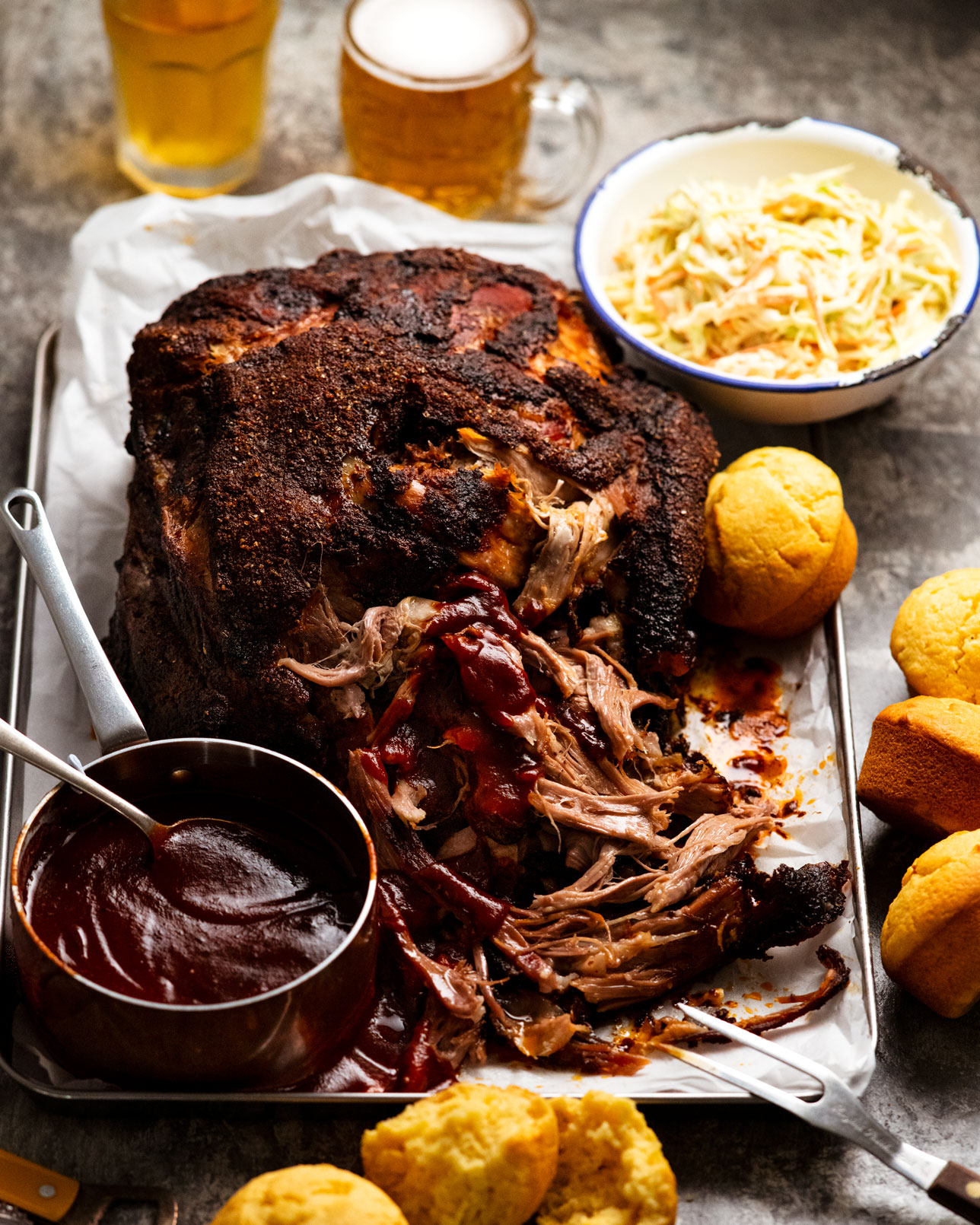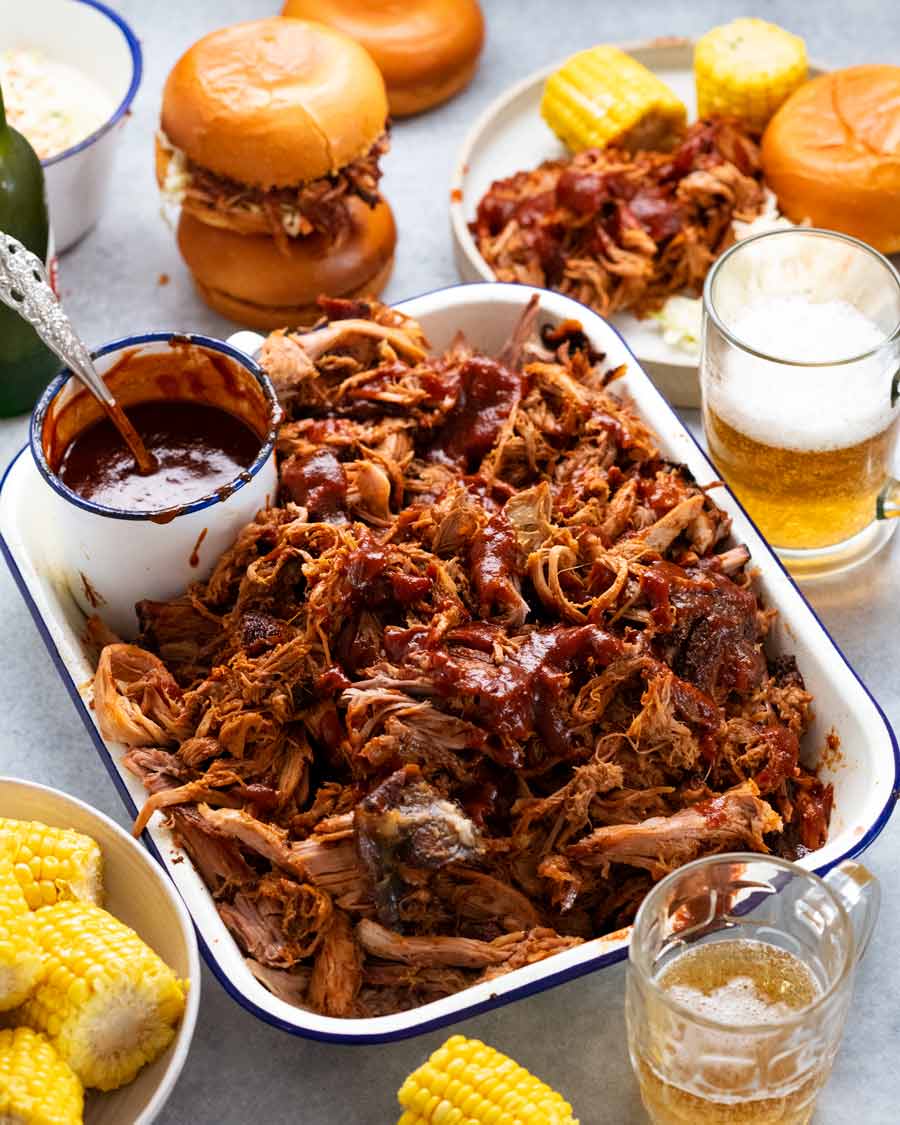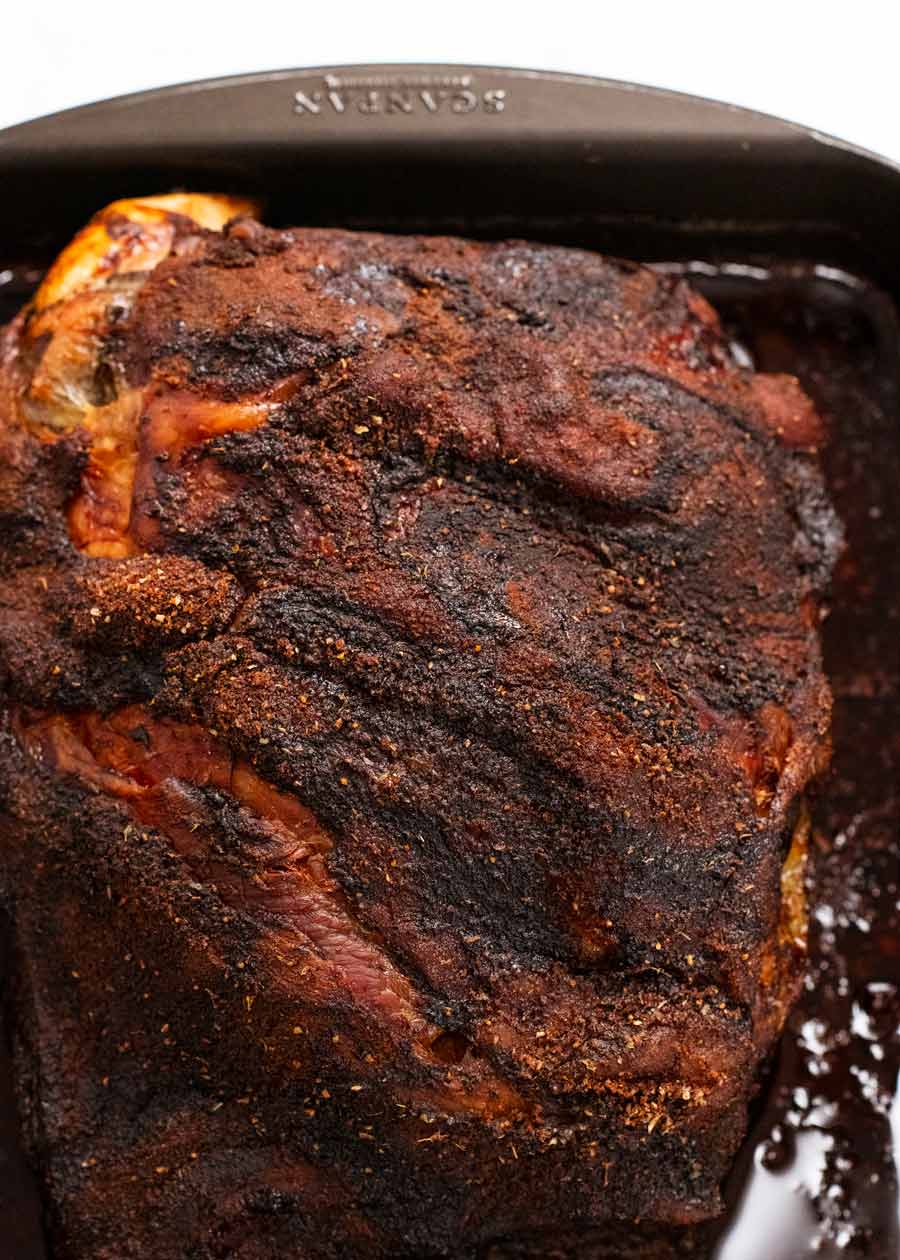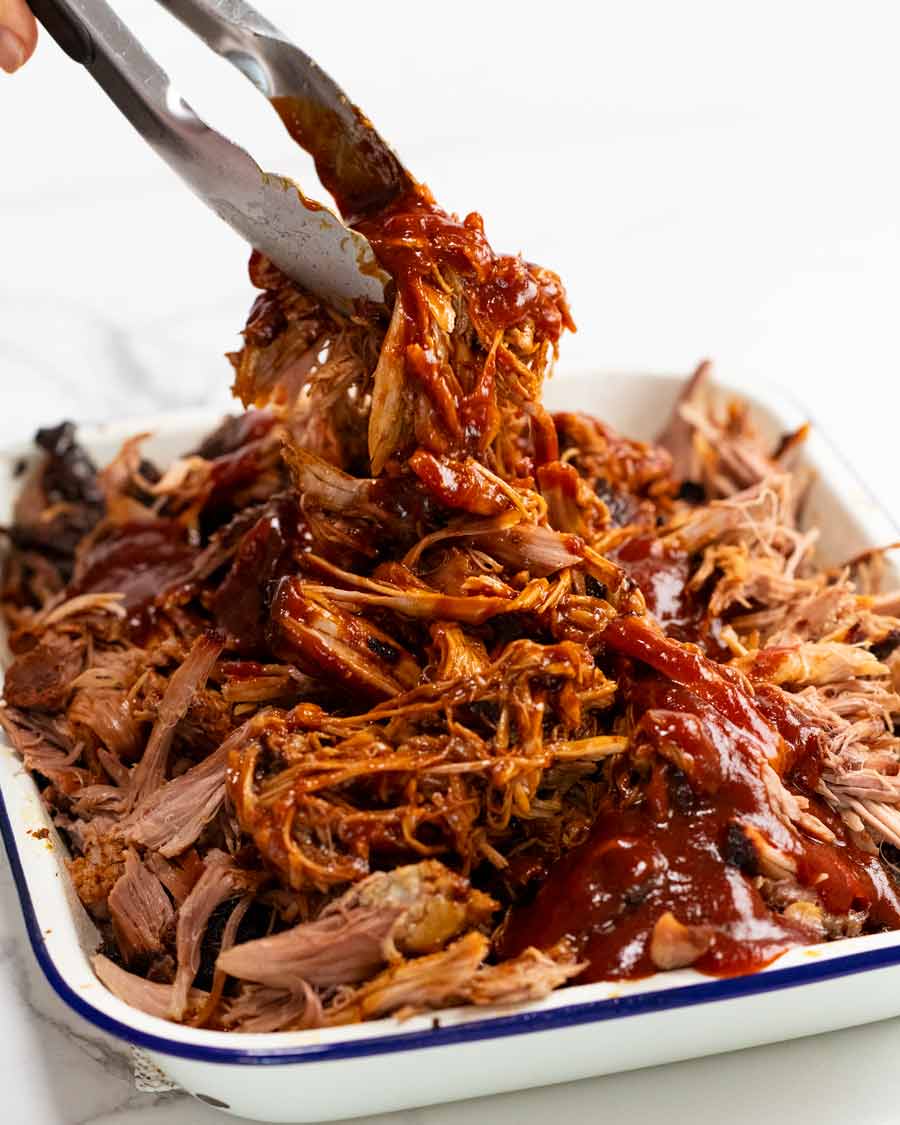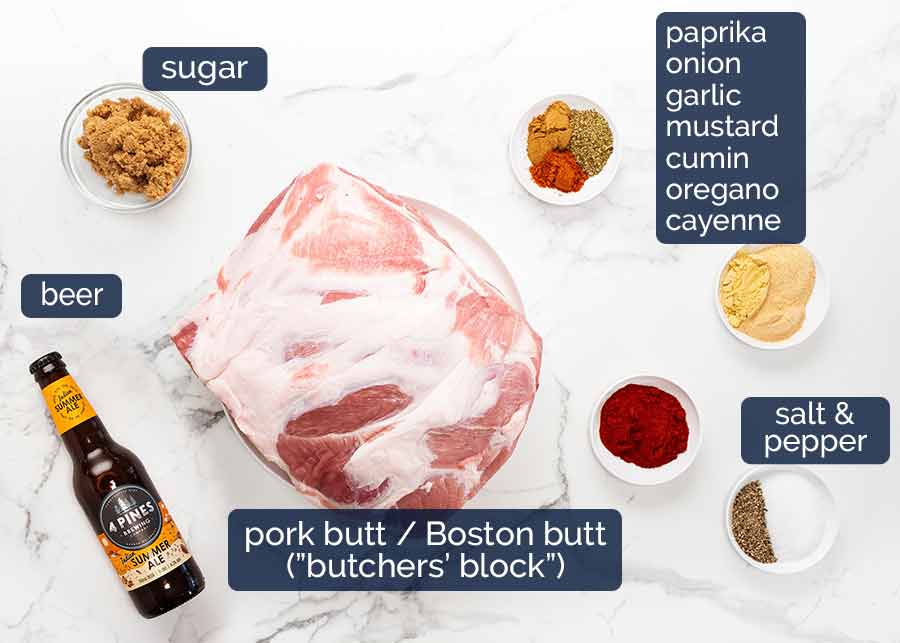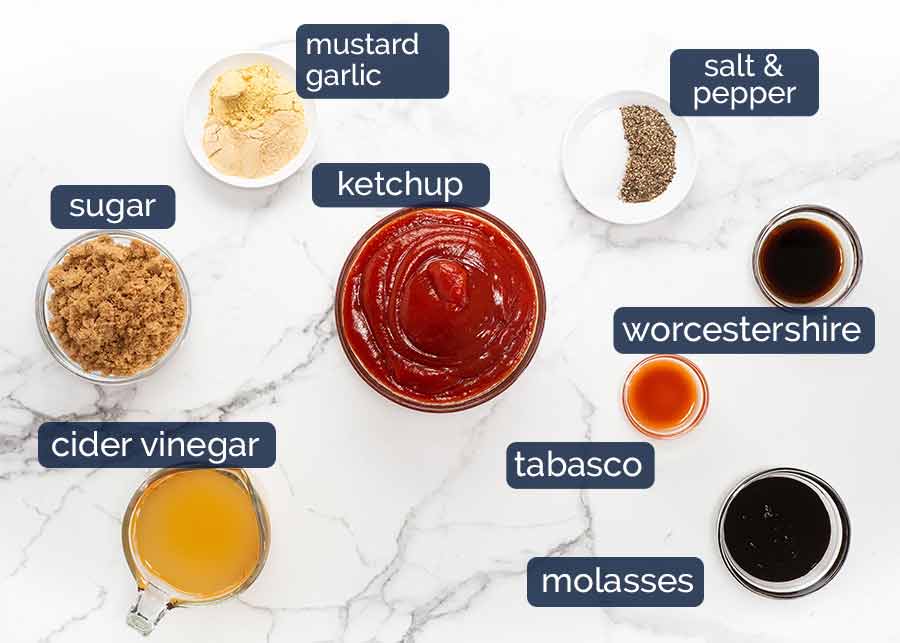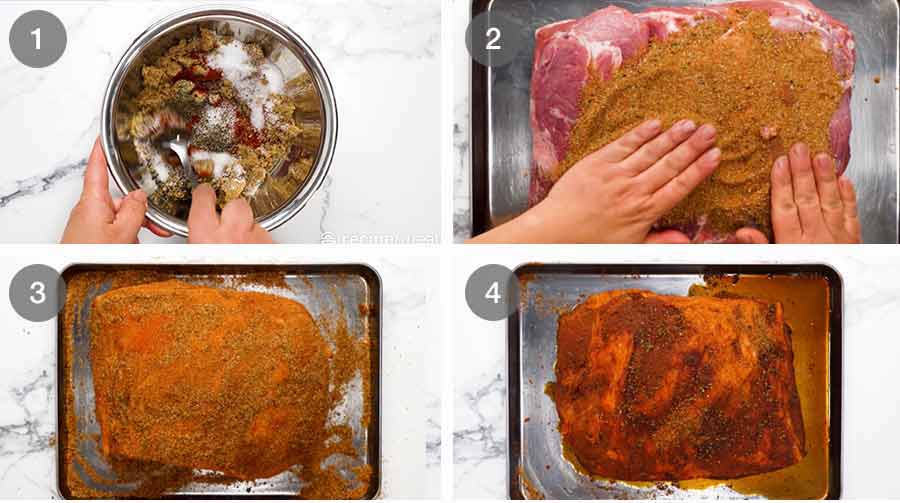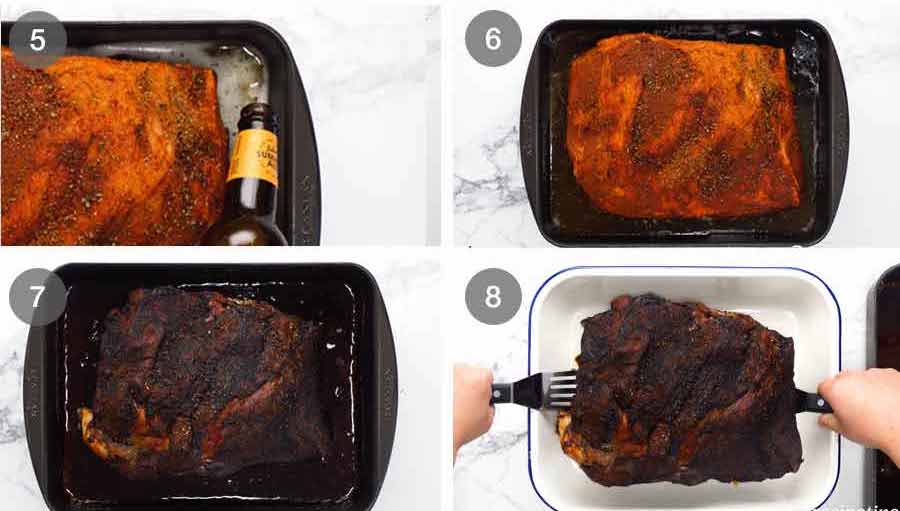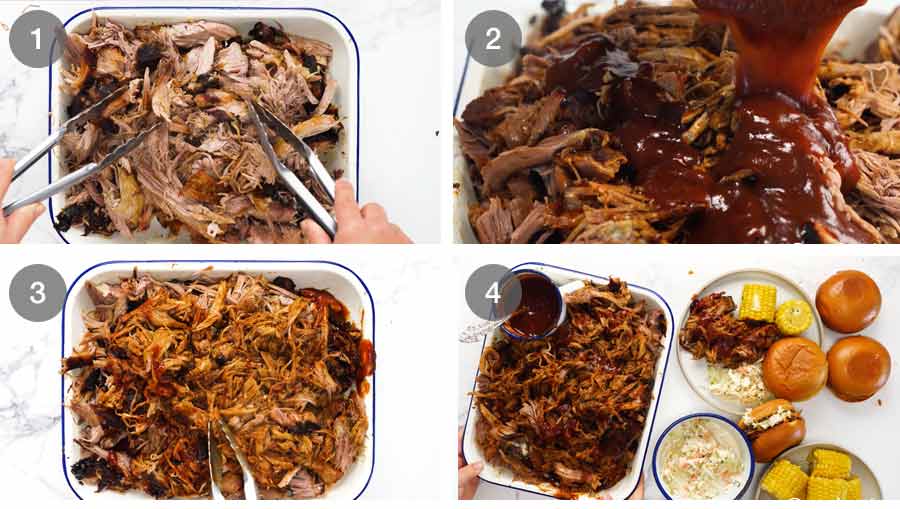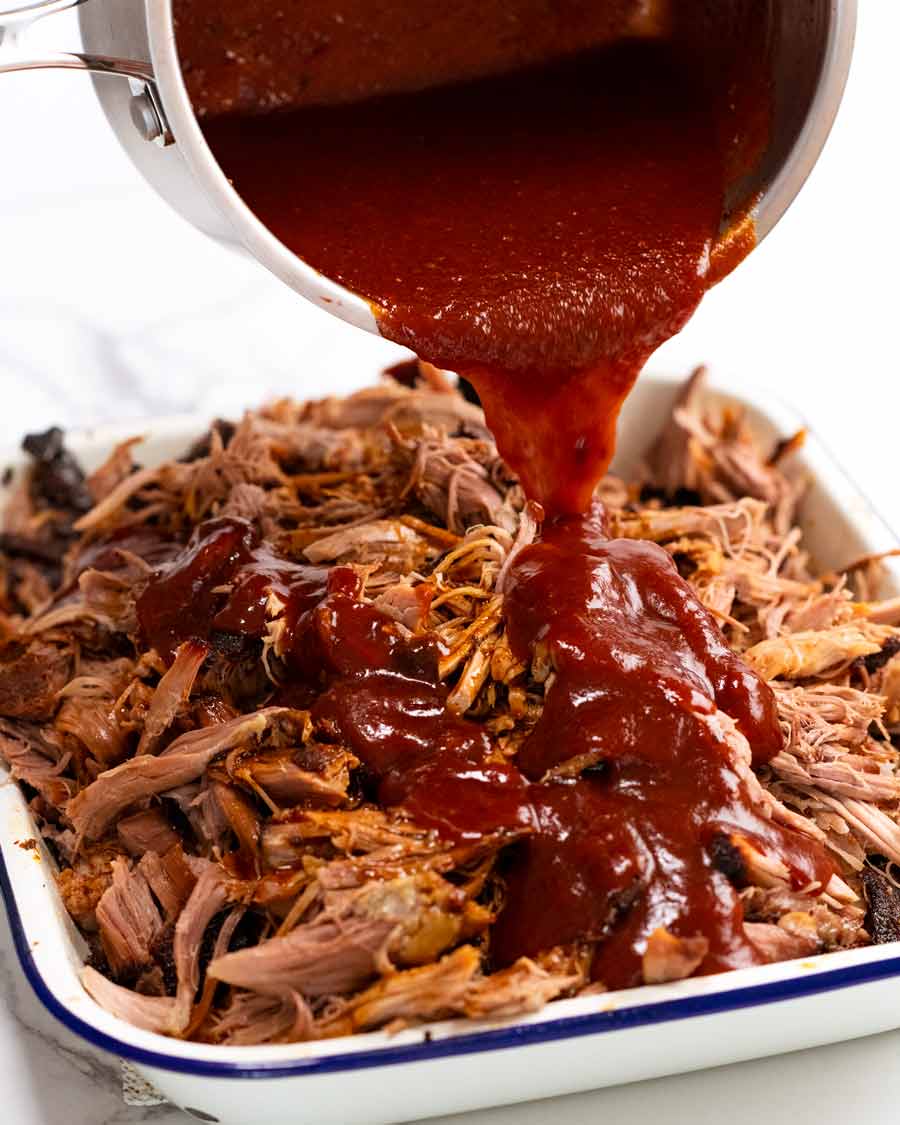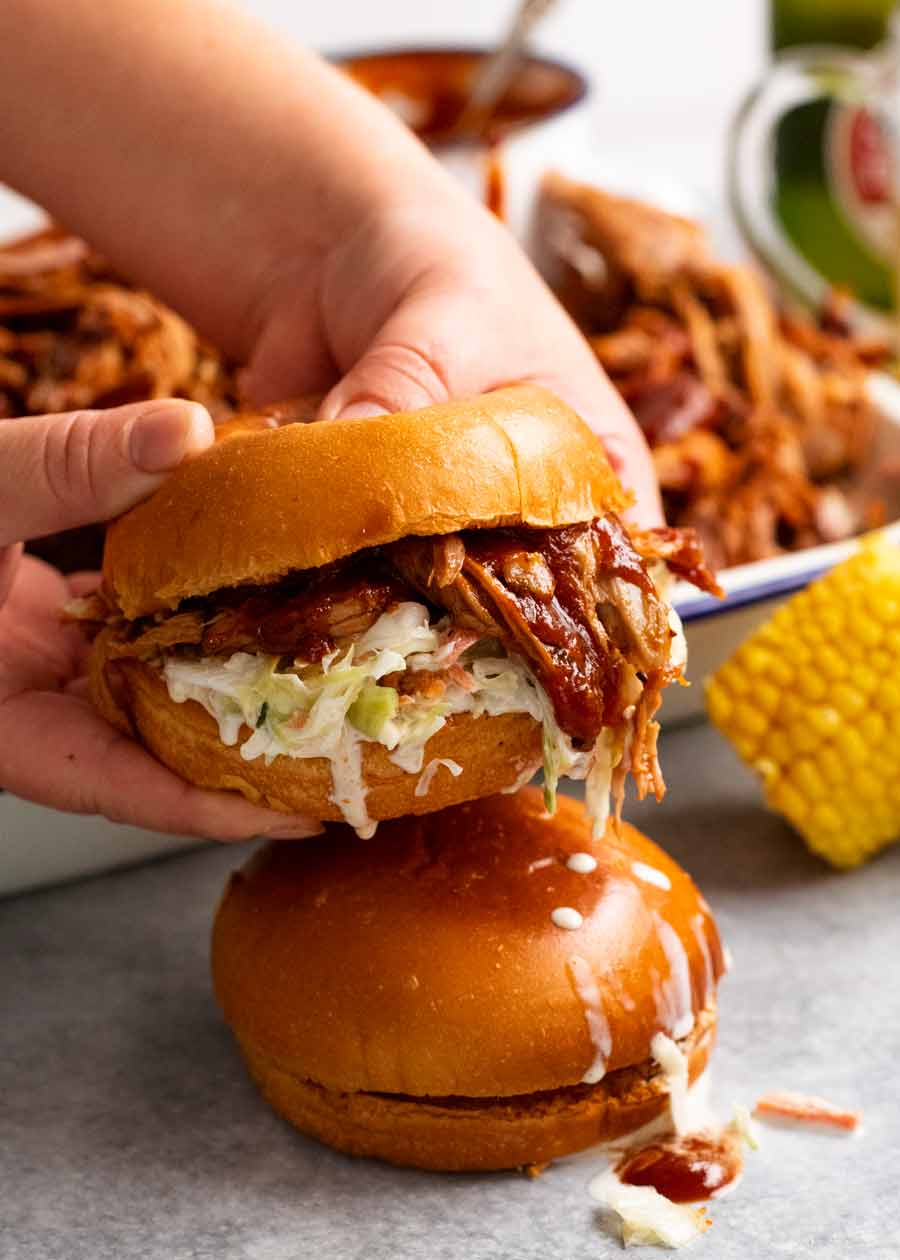Don’t have time for this version? I get it. Make my Slow Cooker Pulled Pork instead!
36-hour Pulled Pork
That’s right, 36 hours is what it takes to make my very best Pulled Pork recipe: A 24-hour dry-brine in a heavily-flavoured rub, followed by a 12-hour slow roast in the oven. I would not share a 36-hour recipe though if I was not 100% sure it produces the very best results! I can assure you it really does, and the reasons are simple: Cooking in this way also gets you that desirable “bark” on the surface that people love about traditional BBQ food. It’s my favourite part. It’s so tempting to lift the whole thing off and run away with it! Check out the proof of epic bark: And proof of ultra-tender, juicy meat:
What you need to make my best Pulled Pork
Here’s what you need for the Pulled Pork:
2 days prior, anytime (usually evening) – Coat pork in rub and leave to brine/marinate for 24 to 48 hours in the fridge.Evening before serving – Put pork in oven to slow-roast overnight.Next morning (day of serving) – Remove pork from oven. Keep whole until required. Shred pork as close as possible to serving time, for optimum juiciness.If serving for lunch – Time the cooking to finish within 2 hours of serving so the pork stays warm, and no need to reheat.If serving for dinner (reheating whole pork) – Allow pork to fully cool on the counter, uncovered (if you cover, bark will go soggy). When cool, cover and refrigerate. Remove from fridge 3 hours prior, leave on counter for 1 hour. Then cover loosely with foil and reheat in a 150°C/300°F oven for 2 hours or until the centre is hot, then shred as close as possible to serving time.Microwave emergency – If you forgot to allow for reheating, you can microwave it uncovered in an emergency. It actually works well because it keeps the meat juicy!
Remove from fridge 3 hours prior, leave on counter for 1 hour. Then cover loosely with foil and reheat in a 150°C/300°F oven for 2 hours or until the centre is hot, then shred as close as possible to serving time.
Pork butt / Boston butt (4 – 5 kg / 8 – 10 lb) – Also known as “butcher’s block” or “square cut shoulder of pork” in Australia, this is a big rectangular block of pork from the of the upper pork shoulder (not its butt!) It’s best for Pulled Pork because it’s well marbled and a uniform shape. It comes with a layer of fat on the surface, no skin (in Australia), and a bone inside. Where to find it – Though widely available and very good value in the US, here in Australia it’s not available at everyday supermarkets. However, it IS sold at Costco! Otherwise, find it at good butchers.What to ask for – Pork butt / Boston butt / butcher’s block / square cut pork shoulder. Describe it as a 4 to 5 kg rectangular block of pork shoulder. Insist / ask politely that it be bone-in, skinless, with some but not all the fat removed from the surface. Best substitute – Regular pork shoulder works but it will need to be a minimum of 3 kg / 6 lb (including the bone). If it’s too small it will cook too fast and defeat the purpose of the 12-hour slow roasting that yields the ultra-juiciness of the meat. Usually here in Australia, pork shoulder is only about 2 – 2.5 kg / 4 – 5 lb (once the skin is removed).Beer – This has multiple purposes. It’s used as (1) the liquid in the pan to prevent the pan from drying out during the slow-roasting, (2) for extra flavour on the pork flesh, and (3) making tasty pan juices which are later tossed through the shredded pork and stirred into the homemade BBQ sauce. Beer type – You can use any beer other than very dark beers like Guinness. Dark beers can be a bit too intense and dominate the pan juice flavours.Substitute with alcoholic apple cider (dry/hard cider), non-alcoholic beer or apple juice, which I’ve used in the past for similar recipes to great success (like BBQ pork ribs).Rub ingredients – The sugar, salt, pepper and spices you see in the photo above are all for the rub. The seasonings (a good number from my 12 Essential Spices list!!) are for flavour, while the salt dry-brines the pork to make it juicier. What is dry-brining? Brining exploits the effect of salt on muscle fibres so meat retains more moisture as it cooks. As a handy bonus, it also fully seasons the meat on the inside – great for large cuts like pork butt. Dry-brining is a type of brining where no water is used, just salt (contrasted with wet-brining where you soak protein in salted water). We get the same effects (juiciness and seasoning) except it’s even better because the flesh isn’t bloated with flavourless water, which dilutes meat’s flavour. It’s also convenient because you don’t have to deal with the logistics of keeping a giant piece of pork submerged in liquid in the fridge.Bottom line: Dry-brining works better and is easier. It’s how I do my turkey every year. Dry brine, dry brine, I say!
Where to find it – Though widely available and very good value in the US, here in Australia it’s not available at everyday supermarkets. However, it IS sold at Costco! Otherwise, find it at good butchers. What to ask for – Pork butt / Boston butt / butcher’s block / square cut pork shoulder. Describe it as a 4 to 5 kg rectangular block of pork shoulder. Insist / ask politely that it be bone-in, skinless, with some but not all the fat removed from the surface. Best substitute – Regular pork shoulder works but it will need to be a minimum of 3 kg / 6 lb (including the bone). If it’s too small it will cook too fast and defeat the purpose of the 12-hour slow roasting that yields the ultra-juiciness of the meat. Usually here in Australia, pork shoulder is only about 2 – 2.5 kg / 4 – 5 lb (once the skin is removed). Beer type – You can use any beer other than very dark beers like Guinness. Dark beers can be a bit too intense and dominate the pan juice flavours. Substitute with alcoholic apple cider (dry/hard cider), non-alcoholic beer or apple juice, which I’ve used in the past for similar recipes to great success (like BBQ pork ribs). What is dry-brining? Brining exploits the effect of salt on muscle fibres so meat retains more moisture as it cooks. As a handy bonus, it also fully seasons the meat on the inside – great for large cuts like pork butt. Dry-brining is a type of brining where no water is used, just salt (contrasted with wet-brining where you soak protein in salted water). We get the same effects (juiciness and seasoning) except it’s even better because the flesh isn’t bloated with flavourless water, which dilutes meat’s flavour. It’s also convenient because you don’t have to deal with the logistics of keeping a giant piece of pork submerged in liquid in the fridge. Bottom line: Dry-brining works better and is easier. It’s how I do my turkey every year. Dry brine, dry brine, I say! Example:
5 kg pork: 5 x 3 = 15 servings (normal portions) or 5 x 2.4 = 12 servings (large portions)10 lb pork: 10 x 1.5 = 15 servings (normal portions) or 10 x 1.2 = 12 servings (large portions)
It might sound like a lot of pork per person (335g – 410g / 11 – 14 oz) but remember, pork loses about 40% of its weight once cooked!
What you need for homemade BBQ Sauce
Nothing groundbreaking here! All the usual classic BBQ sauce suspects are present:
Ketchup – The key ingredient in BBQ sauce. I know it’s totally un-Australian of me to say, but I really prefer ketchup over tomato sauce. Better flavour. Sorry Australia!! Best substitute – Well, tomato sauce!Apple cider vinegar – For the tang in BBQ sauce. Substitute with white or red wine vinegar.Molasses (light/true molasses, NOT blackstrap) – Adds sweetness, colour, gloss and flavour. Easy substitute: golden syrup! Worcestershire sauce – For savoury flavour.Tabasco – Optional, for a hit of heat!Sugar – BBQ sauce is sweet, tangy and a bit savoury. This helps with the sweetness!Mustard and garlic powder – The savoury seasonings. I prefer powdered garlic over fresh garlic, and powdered mustard over mustard spread because the powder versions have a more earthy flavour that I think works better for BBQ sauce.
How to make my best Pulled Pork
It might take 36 hours all up, but it’s actually very straight forward as a process. Also, the brining step, though recommended for truly the best results, can actually be skipped if you want. You still get plenty of flavour on the bark that gets mixed through the meat, as well as in the roasting pan juices that we toss through the meat. The BBQ sauce also adds a good load of flavour!
1. Brining
As mentioned above, a 24-hour dry brine locks in the juices as well as seasoning the flesh right to the middle of that considerable hunk of meat!
2. 12-hour slow-roasting
Shredding
We come to the best part – because you get to pick and nibble throughout the whole process! Get as much rub as possible to stick to the pork, being particularly generous on the top. You will end up with some excess rub loose on the tray, as you can see in the photo above. That’s OK. Can I brine for longer? Yep! I’ve done it for up to 48 hours. I actually didn’t notice a difference between 24 hours and 48 hours however, so there’s no additional benefit to brining for longer. More that if you forgot or the timing suits you, it’s no issue. a) Low temperature – We want to use lowest temperature possible to cook this pork at because the lower the temperature, the less moistures is lost from the flesh of the pork which in turn means juicier pork meat. I found that 110°C/230°F is the minimum temperature for the middle of the pork to peak at 95°C. At this temperature, the meat will be tender enough to shred with no effort. Cooking at a temperature lower than 110°C/230°F, I found the pork never became “fall-apart-at-a-touch”. b) Uncovered – The pork is cooked uncovered so we get that desirable, intensely-flavoured bark on the surface all over the pork. This part is everyone’s favourite! c) Overnight roasting – At such a low temperature and with the amount of liquid we put in the pan, I feel perfectly safe sleeping with the oven on. It’s also super-handy to do the slow-roasting overnight because it’s entirely hands-off. The cooked pork reheats perfectly so I can serve it anytime the next day. d) ⚠️ OVEN AUTO-OFF – Many ovens, including mine, will automatically turn off after 12 hours. This is for safety reasons. So be sure to check if yours has an auto-off function (check the manual)! If it does, firstly preheat the oven, put the pork in then turn it off. Immediately turn it back on (to restart the 12-hr clock, so to speak). Now you’re good to go. Also, how handy that your oven will now turn itself off bang on 12 hours when your pork is ready! There should still be some liquid remaining in the pan. How much depends on a lot of things, like the size of your pork, your oven and so on, but usually there is around 1.5 – 2 cm / 3/4″ of liquid.
Homemade BBQ Sauce
Just briefly, the BBQ sauce. It’s a plonk-and-stir, simmer-for-45-minutes job. Very easy! It can be made at any time that suits you as it keeps and reheats perfectly.
Honestly, that sight … a big pan of juicy meat that’s had my love and attention for the last 36 hours … (albeit I’ve been asleep for most of that time, but that’s not the point!)… now THIS is my kind of food. I know this is totally un-lady like. I’m not the dainty sort, not in my food choices, nor in how I barrel through life. But boy does it make for a tasty life!!! Case in point, Pulled Pork Sandwiches, dripping with pork juices mingling with BBQ sauce. Oh and look, Coleslaw joining the party too: Or, try a big Southern dinner spread by adding classic sides that you’d swear were invented just to serve alongside Pulled Pork!
Great Southern sides to serve with Pulled Pork
As for dessert? Try one of these!
Desserts. Because we ALWAYS have room for dessert!
So, have I convinced you it’s time for a BIG PULLED PORK feast this weekend? Oh, not this weekend? So – next weekend?? 😉 – Nagi x 12 hour roast not for you? I get it. Try my easy Slow Cooker Pulled Pork instead. Long standing reader favourite!
Watch how to make it
Life of Dozer
In digestion mode. Too much Pulled Pork.
